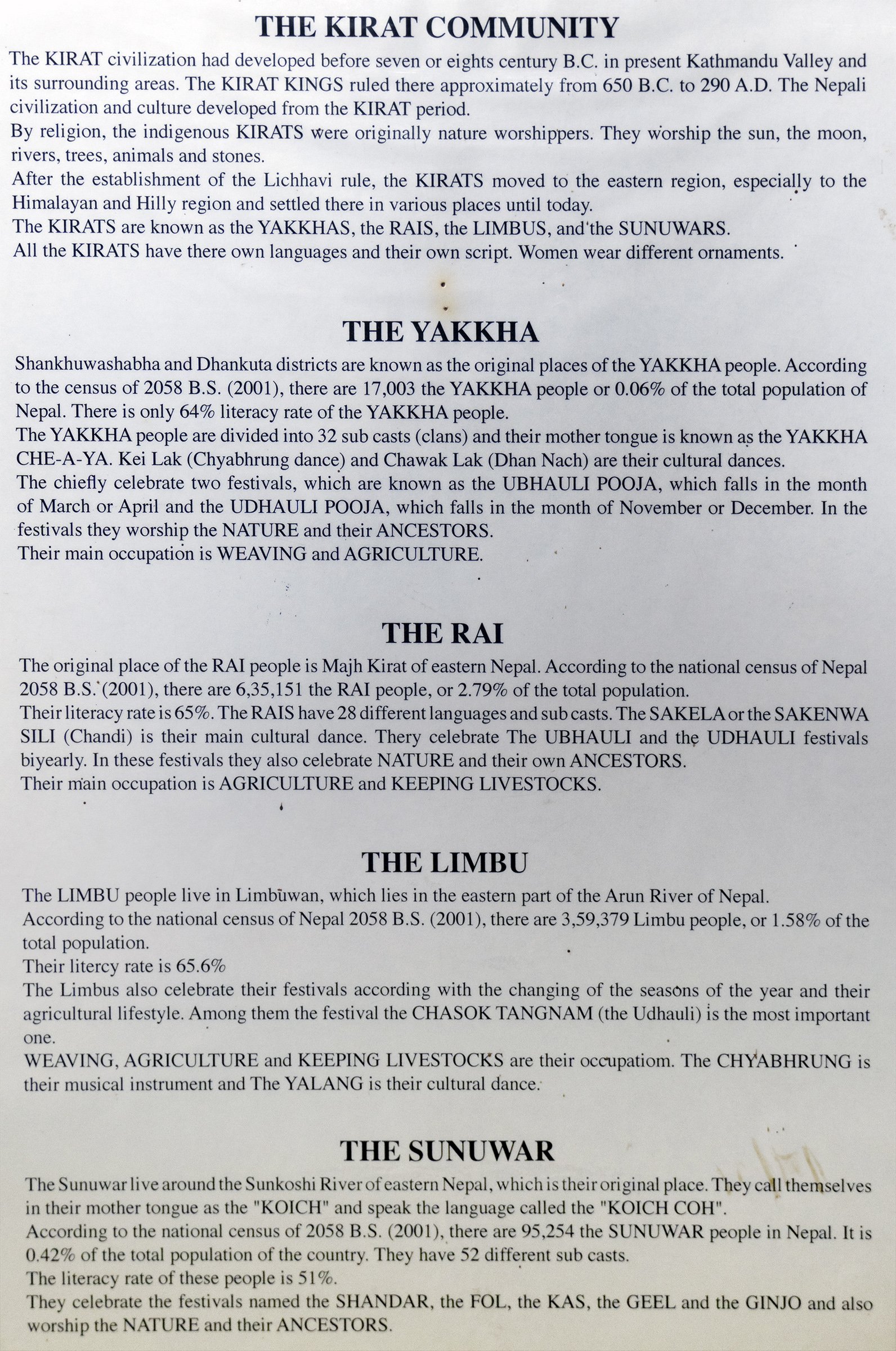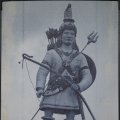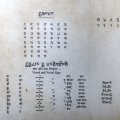The Kirat (ethnic group): photo 2
Photo 2 of 15 in Gallery: The Kirat (ethnic group)

Image title: Kirat cultural information
Description of the photo
The Kirat community:
The Kirat civilization had developed before seven or eights century B.C. in present Kathmandu Valley and its surrounding areas. The Kirat kings ruled there approximately from 650 B.C. to 290 A.D. The Nepali civilization and culture developed from the Kirat period.
By religion, the indigenous Kirats were originally nature worshippers. They worship the sun, the moon, rivers, trees, animals and stones.
After the establishment of the Lichhavi rule, the Kirats moved to the eastern region, especially to the Himalayan and Hilly region and settled there in various places until today.
The Kirats are known as the Yakkhas, the Rais, the Limbus, and the Sunuwars.
All the Kirats have there own languages and their own script. Women wear different ornaments.
The Yakkha:
Shankhuwashabha and Dhankuta districts are known as the original places of the Yakkha people. According to the census of 2058 B.S. (2001), there are 17,003 the Yakkha people or 0.06% of the total population of Nepal. There is only 64% literacy rate of the Yakkha people.
The Yakkha people are divided into 32 sub casts (clans) and their mother tongue is known as the Yakkha Che-a-ya. Kei Lak (Chyabhrung dance) and Chawak Lak (Dhan Nach) are their cultural dances.
The chiefly celebrate two festivals, which are known as the Ubhauli Pooja, which falls in the month of March or April and the Udhauli Pooja, which falls in the month of November or December. In the festivals they worship the Nature and their Ancestors.
Their main occupation is Weaving and Agriculture.
The Rai:
The original place of the Rai people is Majh Kirat of eastern Nepal. According to the national census of Nepal 2058 B.S. (2001), there are 6,35,151 the Rai people, or 2.79% of the total population.
Their literacy rate is 65%. The Rais have 28 different languages and sub casts. The Sakela or the Sakenwa Sili (Chandi) is their main cultural dance. They celebrate The Ubhauli and the Udhauli festivals biyearly. In these festivals they also celebrate Nature and their own Ancestors.
Their main occupation is Agriculture and Keeping Livestocks.
The Limbu:
The Limbu people live in Limbuwan, which lies in the eastern part of the Arun River of Nepal.
According to the national census of Nepal 2058 B.S. (2001), there are 3,59,379 Limbu people, or 1.58% of the total population.
Their litercy rate is 65.6%
The Limbus also celebrate their festivals according with the changing of the seasons of the year and their agricultural lifestyle. Among them the festival the Chasok Tangnam (the Udhauli) is the most important one.
Weaving, Agriculture and Keeping Livestocks are their occupation. The Chyabhrung is their musical instrument and The Yalang is their cultural dance.
The Sunuwar:
The Sunuwar live around the Sunkoshi River of eastern Nepal, which is their original place. They call themselves in their mother tongue as the “Koich” and speak the language called the “Koich Coh”.
According to the national census of 2058 B.S. (2001), there are 95,254 the Sunuwar people in Nepal. It is 0.42% of the total population of the country. They have 52 different sub casts.
The literacy rate of these people is 51%.
They celebrate the festivals named the Shandar, the Fol, the Kas, the Geel and the Ginjo and also worship the Nature and their Ancestors.
Gallery information:
The Kirat people are an ancient civilization from Nepal whose kings ruled in Kathmandu valley since at least 650 B.C. Their native religion consists of worshopping natural entities. The Kirats consists of several groups of which the major branches are called the Yakha, Rai, Limbu and the Sunuwar
Photo details:
Date: 2019-11-11
Camera: SONY ILCE-6400
Exposure: 1/25
Aperture: f/4.5
ISO: 500
Focal length: 35mm
High resolution:
Download file
Size: 1.76 MB
Resolution: 1592 x 2400
© Photograph by Gabe Hiemstra.
License: CC BY-NC-ND 4.0

